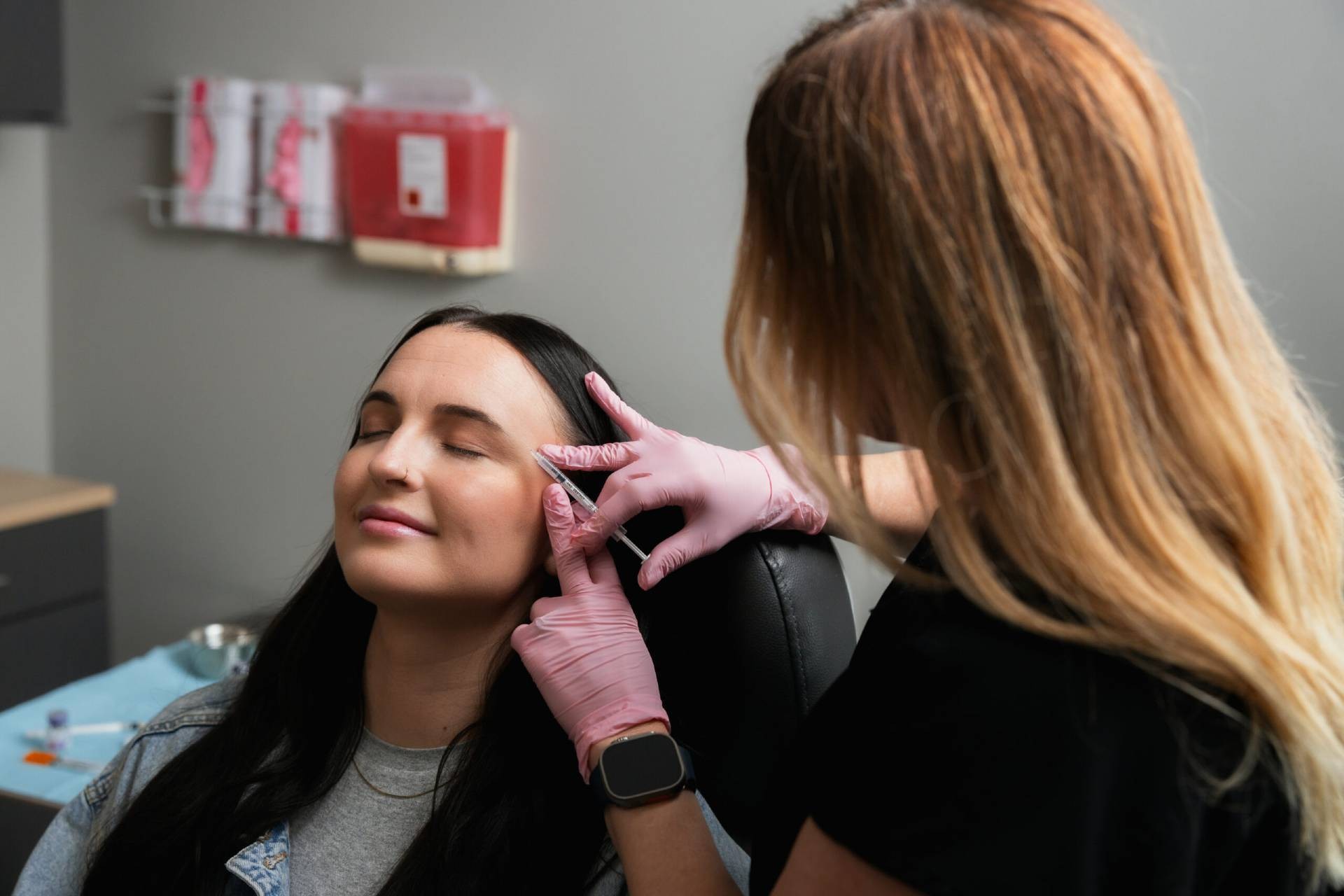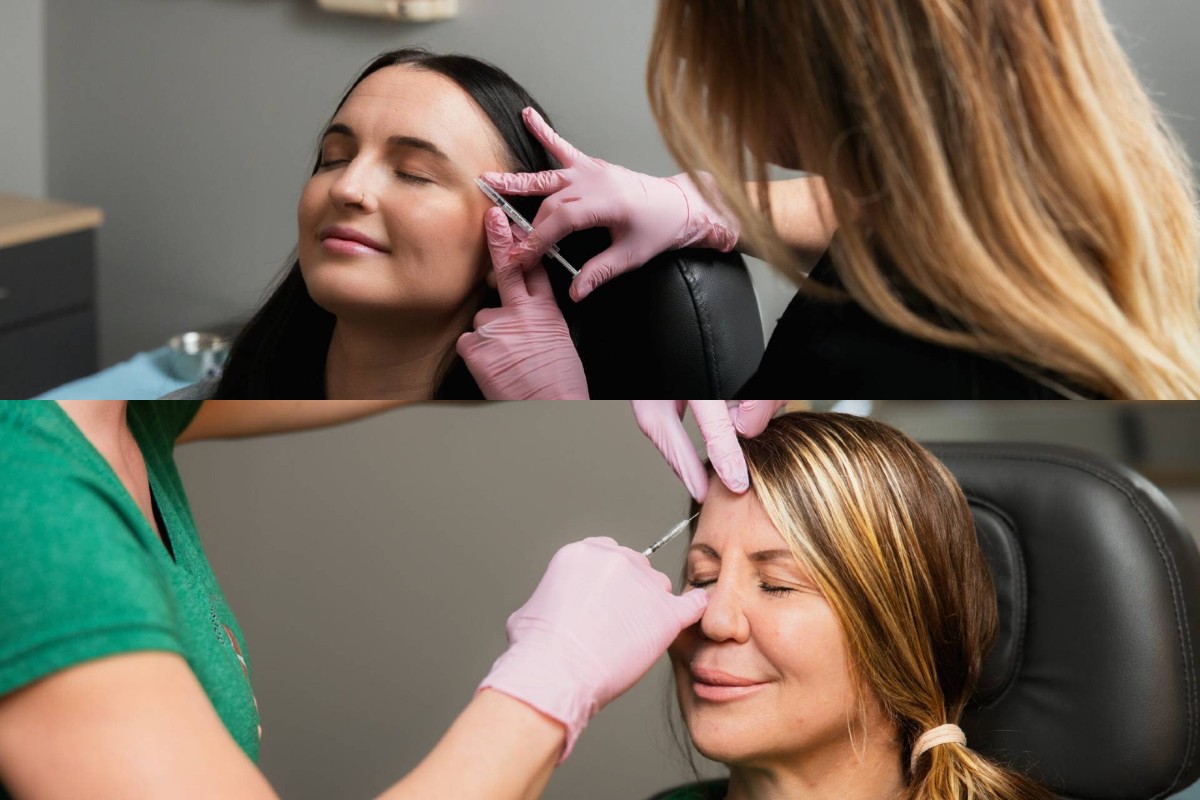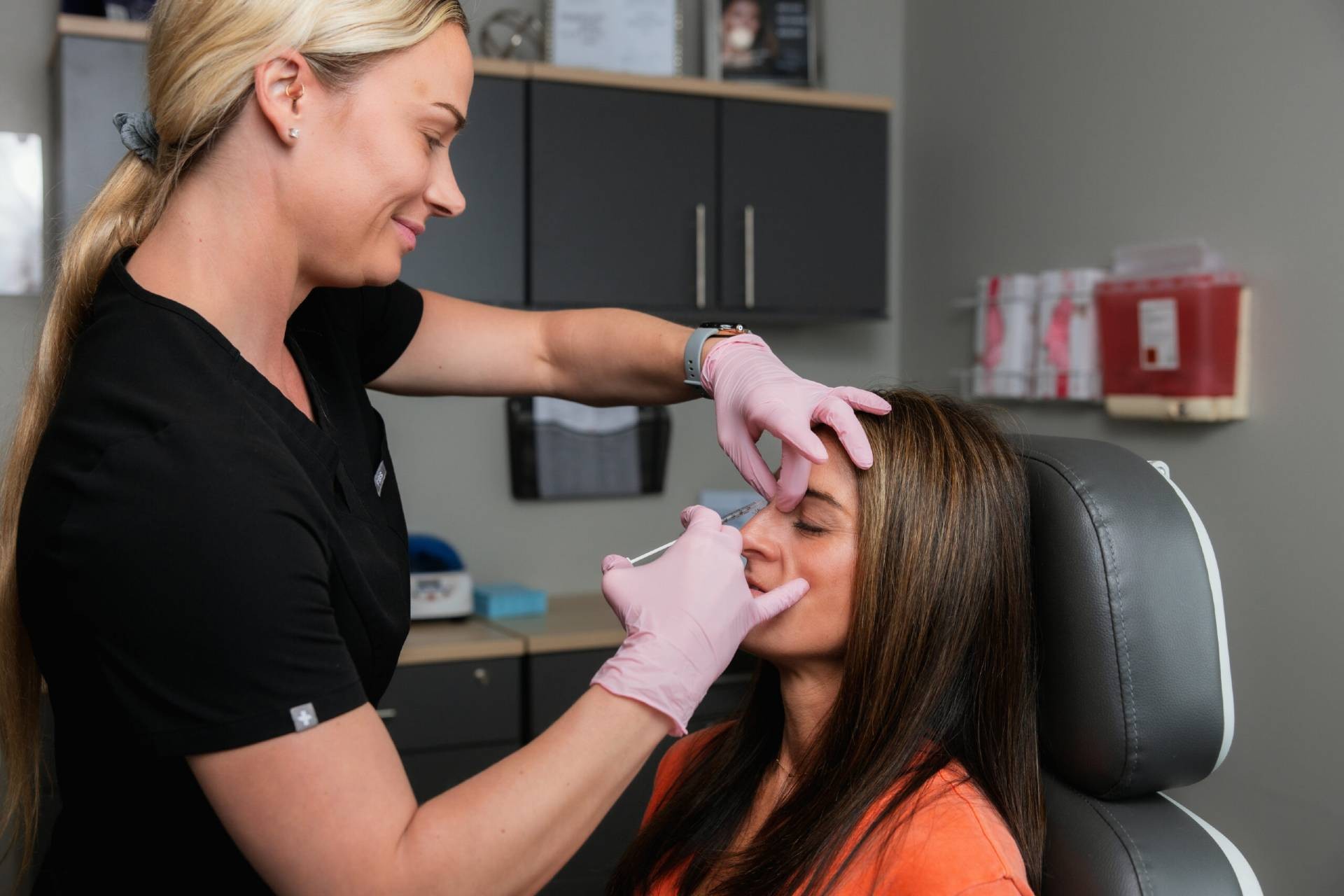Growing older is a beautiful thing – but it can also alter our appearance and, subsequently, our confidence. If you’re noticing the appearance of fine lines and wrinkles on your face, you might be bummed out, or you may be scouring the internet looking for surgeries, face creams, or other types of treatment to reverse or repair these signs of aging. When it comes to non-surgical solutions for reducing fine lines and wrinkles, few treatments have gained as much recognition as Botox and Dysport. Both are neuromodulators that relax facial muscles to smooth the skin and minimize wrinkles; however, they differ in subtle but important ways. At Atomic Dermatology and Med Spa in Pasco, Washington, we offer both treatments, providing our patients with customized solutions that suit their individual needs.
This comprehensive guide will break down the similarities and differences, comparing Dysport vs. Botox and exploring how each treatment works. It will also compare their effectiveness, cost, and side effects to help you make an informed decision about which treatment is best for you.
Who Are We: Atomic Dermatology and Med Spa
Atomic Dermatology and Med Spa is one of the leading skincare providers in Washington. Our experienced team, led by board-certified dermatologists, nurse practitioners, and licensed aestheticians, specializes in a range of aesthetic and medical treatments to help our clients look and feel their best.
From wrinkle relaxers like Botox and Dysport to advanced laser treatments and chemical peels, our practice provides expert care in a safe, professional, and welcoming environment. We are proud to offer personalized consultations for Botox and Dysport treatments, ensuring that each patient receives individualized recommendations tailored to their facial anatomy, skin, and aesthetic goals.
What is Botox?
Botox, or onabotulinumtoxinA, is an injectable treatment that uses a purified form of botulinum toxin type A to temporarily paralyze or relax muscles that cause dynamic wrinkles—or those pesky lines formed through repetitive facial movements like smiling, frowning, or squinting. When injected into the targeted areas, Botox blocks nerve signals to the muscles, preventing them from contracting and creating wrinkles.
As the muscles relax, the skin becomes smoother, and lines are less noticeable.
Botox was first approved by the FDA for cosmetic use in 2002, and it has since become one of the most widely used and recognized wrinkle treatments worldwide. It is particularly effective for treating:
- Crow’s feet – lines around the eyes
- Forehead lines – horizontal wrinkles across the forehead
- Frown lines – vertical lines between the eyebrows, also known as “11s.”
- Other areas – lines around the mouth, lips, nose, or neck
Botox treatments take 10 to 15 minutes and are virtually painless, with most patients experiencing only minor discomfort from the injections. The full effects of Botox typically become visible within 7 to 10 days, with results lasting 3 to 4 months. Regular treatments are recommended for patients who want to maintain their wrinkle-free appearance.
What is Dysport?
Dysport, or abobotulinumtoxinA, is another botulinum toxin type A injectable that works similarly to Botox. It temporarily relaxes the muscles responsible for creating wrinkles, offering a smoother, more youthful appearance. Like Botox, Dysport is FDA-approved for cosmetic use and has gained popularity for its ability to treat similar areas of the face.
The key areas Dysport targets include:
- Forehead lines
- Crow’s feet
- Frown lines (glabellar lines)
While Botox is more commonly used in the U.S., Dysport is a popular choice in Europe and is gaining traction stateside due to certain advantages in treating larger areas of the face, like the forehead. Dysport tends to diffuse more widely than Botox, making it ideal for patients who need a broader area of treatment. This diffusion characteristic often results in fewer injections for effective treatment, making the patient more comfortable.
Dysport takes effect slightly faster than Botox, with many patients noticing visible improvements within 2 to 3 days. Like Botox, the effects of Dysport typically last 3 to 4 months, depending on the individual.
Critical Differences Between Botox and Dysport
Botox and Dysport both derive from botulinum toxin type A and function similarly. They are often used to target the same areas. However, several differences when comparing Dysport vs. Botox might influence which treatment is best for you. Let’s explore these differences in more detail:
1. Result Onset Time
One of the most notable differences between Botox and Dysport is how quickly each treatment takes effect. While Botox’s final results typically appear within 7 to 10 days, Dysport works faster, with patients often noticing improvements within 2 to 3 days. If you’re looking for faster results, Dysport might be a better choice, especially if you’re preparing for a special event.
However, some individuals may prefer Botox’s gradual onset, which allows for a more subtle improvement over a week. This is particularly important for patients who want their results to look as natural as possible without drawing attention to the fact that they’ve had treatment.
2. Spread and Precision
Another significant difference between Dysport vs. Botox is how the product spreads once injected. Dysport is known to diffuse more widely than Botox, which spreads over a larger area. This characteristic makes Dysport ideal for treating larger areas, like the forehead, potentially with fewer injections.
On the other hand, Botox tends to stay more localized, allowing for more precision in treating smaller areas of the face. For example, when targeting crow’s feet or frown lines, Botox’s precise application can ensure that only the desired muscles are treated, leaving other facial expressions unaffected.
3. Dysport vs. Botox Dosage Differences
Dysport and Botox are dosed differently, which can sometimes lead to confusion among patients. Dysport is more diluted than Botox, requiring more units to achieve the same effect. Typically, Dysport is dosed at a ratio of 2.5 units for every 1 unit of Botox, meaning 25 units of Dysport have approximately the same results as 10 units of Botox. However, Dysport is often priced lower per unit despite requiring more units, making the overall cost comparable to Botox in many cases.
It’s important to note that the dosage and number of units required can vary depending on the individual’s facial anatomy, muscle strength, and the areas being treated. At Atomic Dermatology and Med Spa, we ensure that each treatment is appropriately dosed to provide natural-looking results.
4. Molecular Composition and Protein Structure
Botox and Dysport use botulinum toxin type A, but their molecular structures differ slightly. Dysport contains smaller protein molecules than Botox, which is one reason it spreads more easily across larger face areas. This structural difference may also affect how each patient’s body metabolizes the product.
For some patients, Botox’s larger molecular size may allow it to stay in the targeted muscles longer, which could result in slightly longer-lasting results. However, some studies and trials show that Dysport lasts longer. These differences are minimal; treatments typically last around 3 to 4 months.
5. Effectiveness and Results
Both Botox and Dysport are highly effective at reducing the appearance of wrinkles and fine lines. However, due to their spread, onset time, and molecular composition differences, one treatment may better suit particular areas of the face or your specific aesthetic goals.
Botox Effectiveness
Botox is particularly well-suited for patients who require precise, targeted treatment for smaller areas of the face. It’s often the treatment of choice for crow’s feet or the fine lines around the eyes that form from smiling and squinting. It is also famous for frown lines, the vertical lines between the eyebrows that form from frowning or concentrating, and forehead lines, the horizontal wrinkles that form from raising the eyebrows. Patients who prefer a more gradual onset of results or who are new to injectable treatments may also feel more comfortable starting with Botox.
Dysport Effectiveness
Dysport is often recommended for patients with more extensive treatment areas or those who want faster results. It’s especially effective for forehead wrinkles as its wider diffusion allows for more even treatment across the entire forehead, reducing the appearance of horizontal lines with fewer injections. It is also FDA-approved for treating glabellar lines (frown lines), and its fast-acting results make it a popular choice for patients who want to see improvements within just a few days.
Some patients report that Dysport provides a slightly softer, more natural look, while others find Botox gives them a more “frozen” appearance. This can vary from person to person, and the best way to determine which product is right for you is through a personalized consultation at Atomic Dermatology and Med Spa.
Potential Side Effects of Botox and Dysport
When comparing Dysport vs. Botox, both treatments are considered safe when administered by trained professionals, but like any cosmetic treatment, they can come with potential side effects. These side effects are usually mild and temporary, but it’s essential to be aware before deciding on treatment.
Common Dysport vs. Botox Side Effects
The most common side effects of both Botox and Dysport include mild bruising or swelling at the injection site, temporary redness or tenderness, and minor headaches. These side effects typically resolve within a few hours to a few days. Most patients experience no downtime and can resume normal activities immediately after either treatment.
Rare but Serious Side Effects
While serious side effects are rare, they can occur, mainly if the product spreads to unintended areas of the face or body. Some potentially severe side effects include drooping eyelids (ptosis), facial asymmetry, or, in rare cases, difficulty swallowing or breathing.
At Atomic, we minimize the risk of side effects by using advanced injection techniques and carefully selecting the appropriate dosage for each patient. We also provide thorough consultations to review your medical history and ensure that Botox or Dysport is administered safely.
Which Treatment is Right for You?
Choosing Dysport vs. Botox ultimately depends on your facial anatomy, aesthetic goals, and preferences for onset time and treatment precision. Here’s a quick guide to help you determine which treatment might be proper for you:
Choose Botox If: You’re looking for precise, targeted treatment for smaller areas like crow’s feet or frown lines, and you prefer a gradual onset of results.
Choose Dysport If: you want faster results and larger areas to treat, like forehead wrinkles. Dysport’s broader diffusion allows for more even coverage with fewer injections.
At Atomic Dermatology and Med Spa, we provide personalized consultations to help you decide which treatment is best for your needs. During your consultation, we’ll assess your skin, discuss your goals, and recommend the most appropriate treatment plan.
Dysport vs. Botox: The Cost Comparison
The cost of Botox and Dysport can vary depending on the area being treated and the number of units required. Dysport is typically priced lower per unit than Botox, but because more units of Dysport are usually needed, the overall cost of treatment is often comparable.
At Atomic Dermatology, we believe in transparency. During your consultation, we’ll provide a detailed breakdown of the costs associated with your treatment based on our recommended number of units. Our team will help you understand the price per unit and how the total cost may vary based on the areas you want to treat.
Choosing Dysport vs. Botox at Atomic Dermatology and Med Spa
When considering Dysport vs. Botox, we know they are both highly effective treatments for reducing fine lines and wrinkles, and each offers unique benefits. Whether you prioritize fast results with Dysport or more precise targeting with Botox, both treatments can help you achieve a smoother, more youthful appearance.
At Atomic Dermatology and Med Spa, we are committed to helping our clients make informed decisions about their skincare. If you’re still unsure which treatment is right for you, our experienced team is here to help. We discuss your specific aesthetic goals, both short and long-term, preferences, budget, and potential side effects. If you want an experienced partner to move forward with your skincare journey, contact Atomic Dermatology and Med Spa today to schedule a personalized consultation to find the optimal treatments and solutions!
